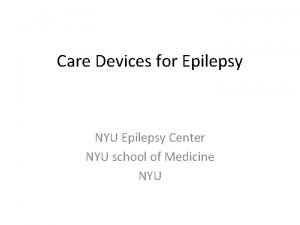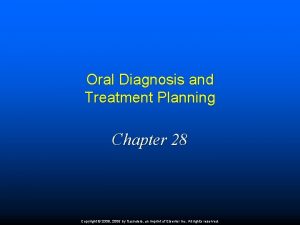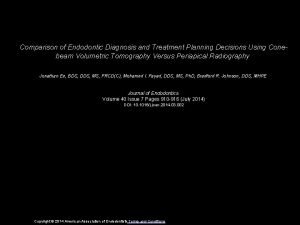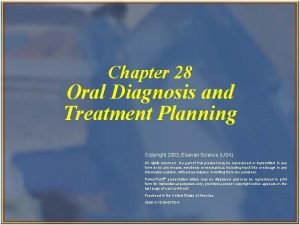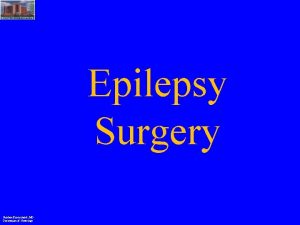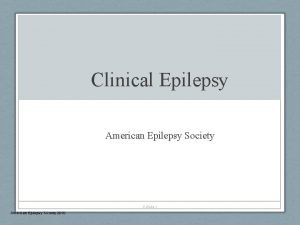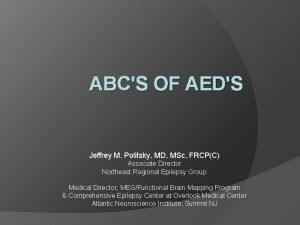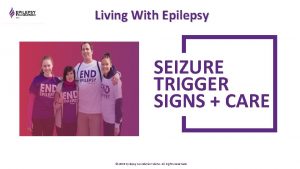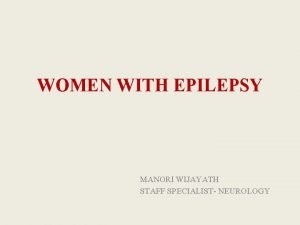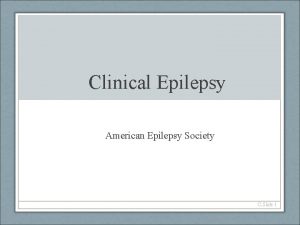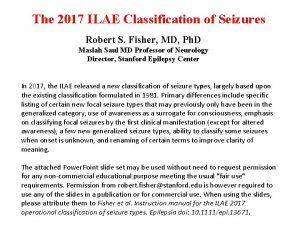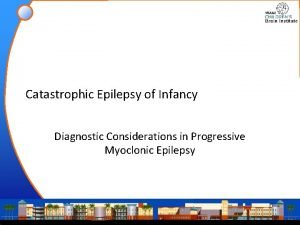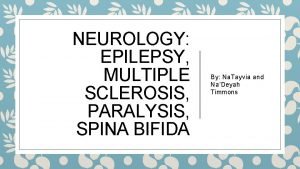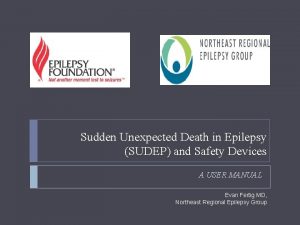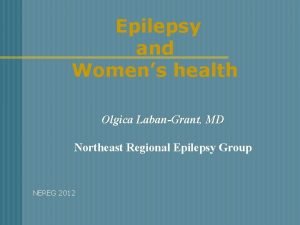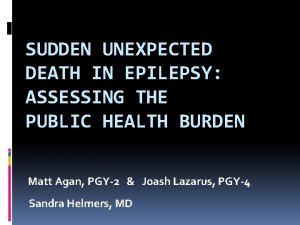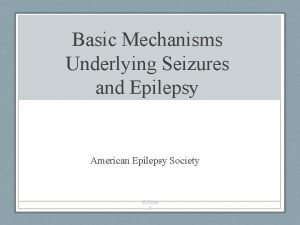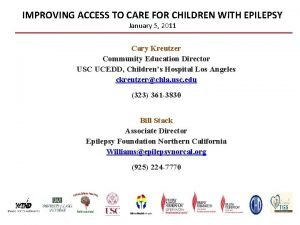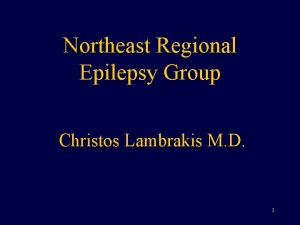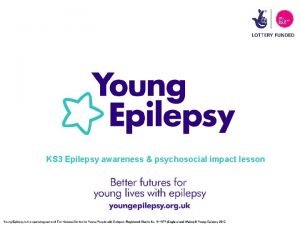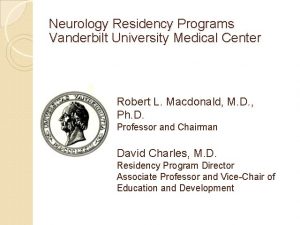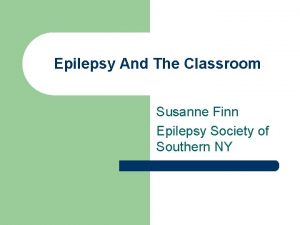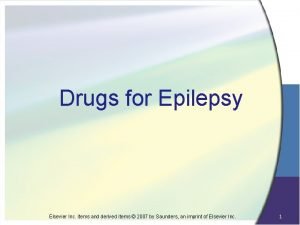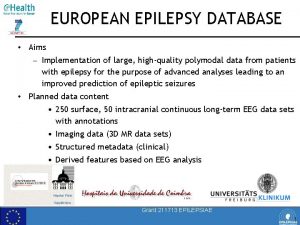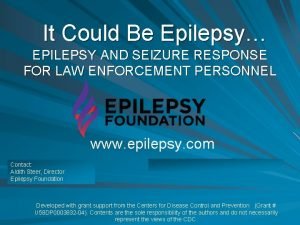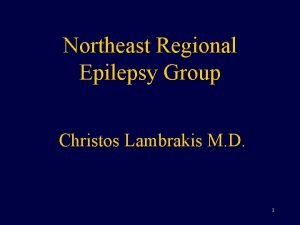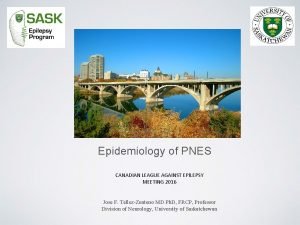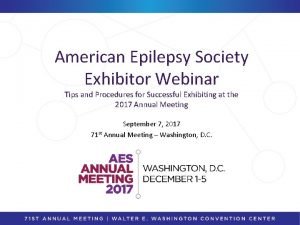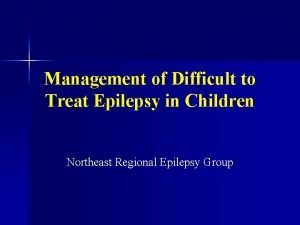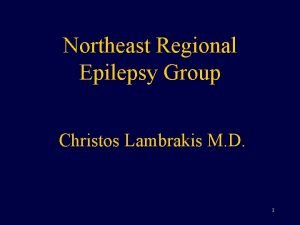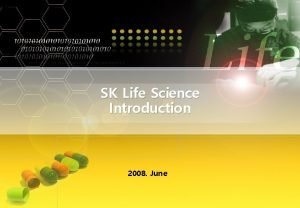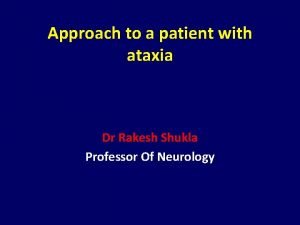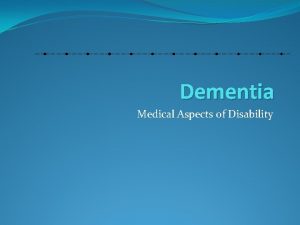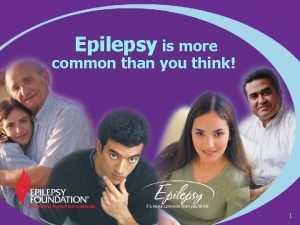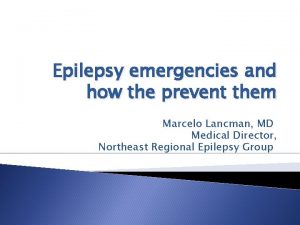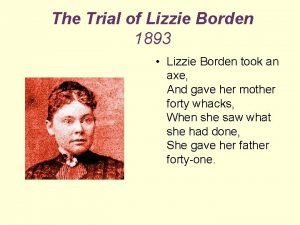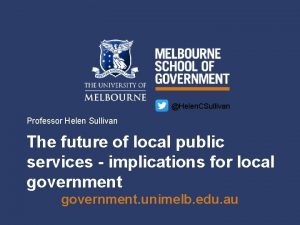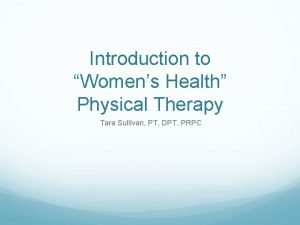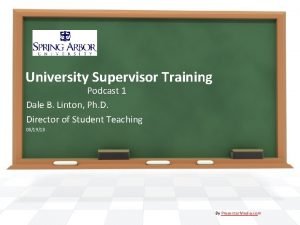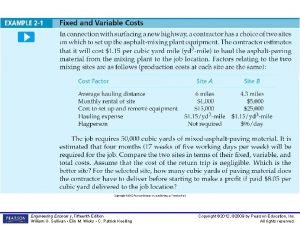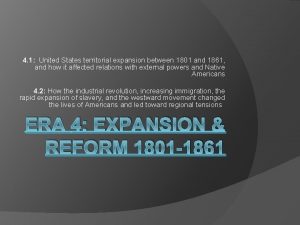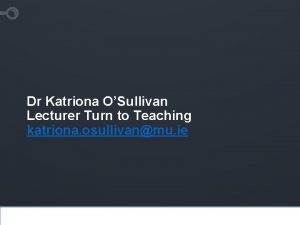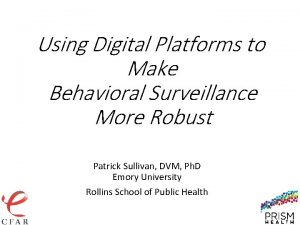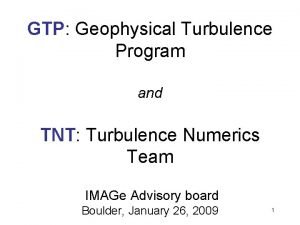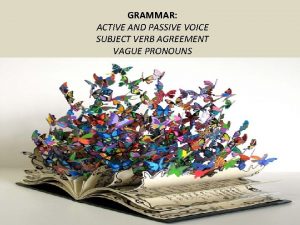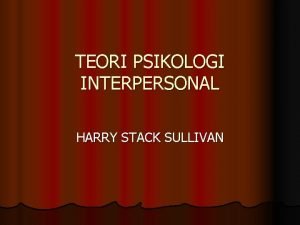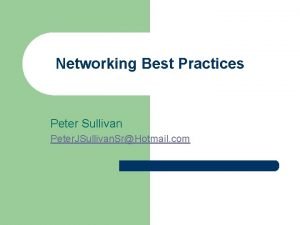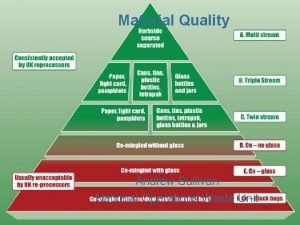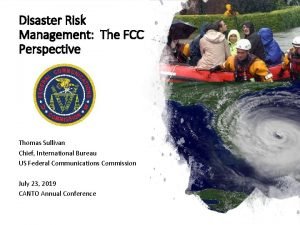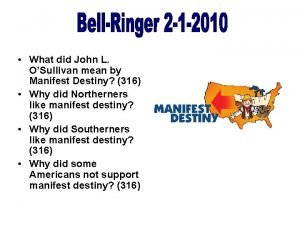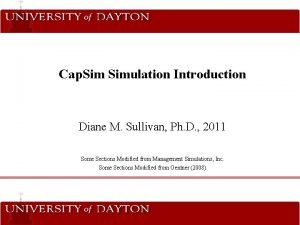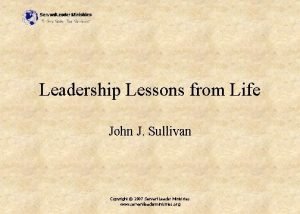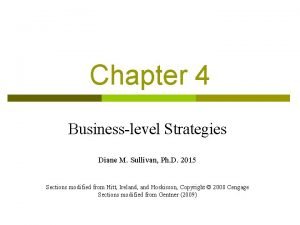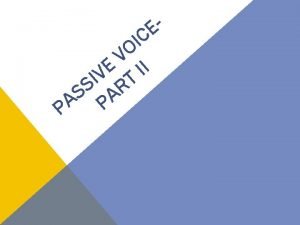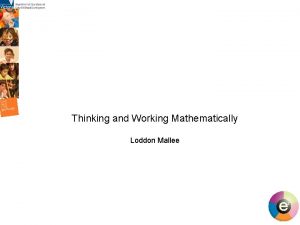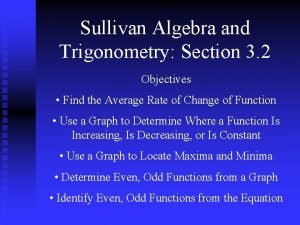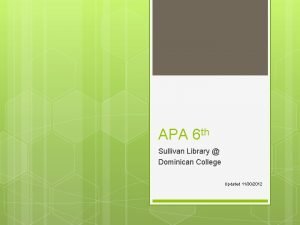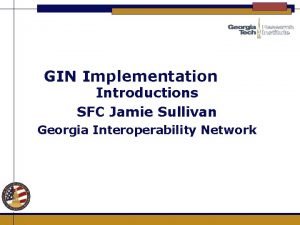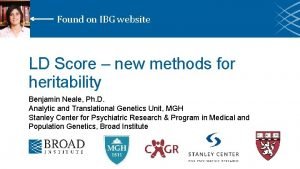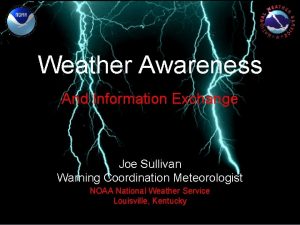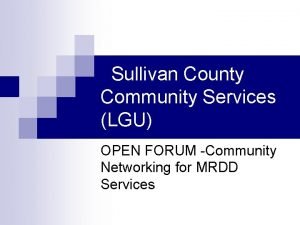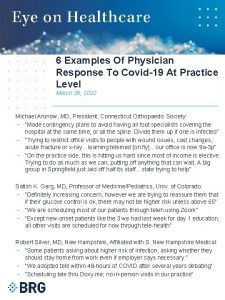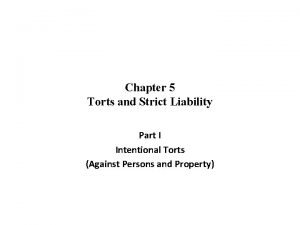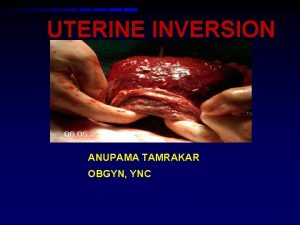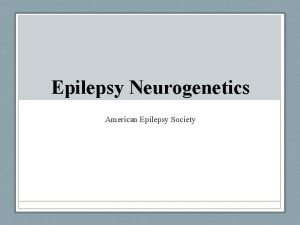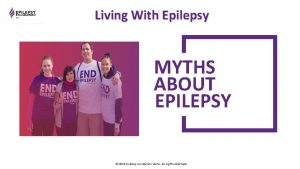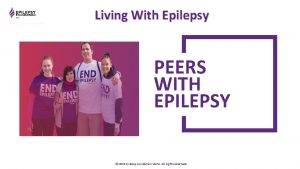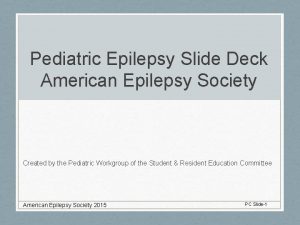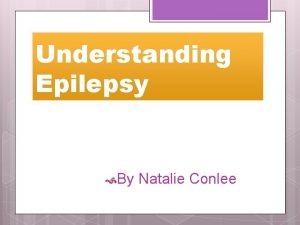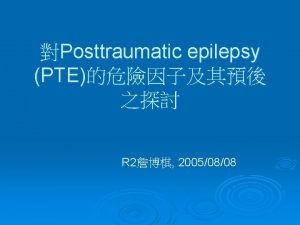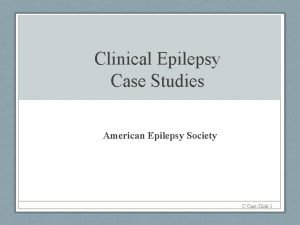Diagnosis Treatment of Pediatric Epilepsy Joseph E Sullivan




























































































- Slides: 92

Diagnosis & Treatment of Pediatric Epilepsy Joseph E. Sullivan, M. D. Assistant Professor of Clinical Neurology & Pediatrics Director, UCSF Pediatric Epilepsy Center

Outline Proper seizure/epilepsy classification Why treat? When to treat? Treatment options Outcomes

Epilepsy Classification History, history Tests are ancillary and rarely confirmatory Describe what the observer saw FIRST! Behavior arrest Staring Eye deviation Myoclonic jerk



“New-onset” seizure clinic History, history from the WITNESS 74% were diagnosed epileptic (94/127) 36% had previous ambiguous event 41% had abnormal EEG 64% were imaged and 18% were abnormal Hamiwaka, LD, et. al. Epilepsia, 48(6): 1062 -66, 2007

Infantile Spasm

Head drop/atonic

Atonic-myoclonic

Eyelid Myoclonia

Focal Seizures Focal sensory Focal motor Clonic Asymmetric tonic posturing With automatisms Gelastic Secondarily generalized seizures

Focal clonic

Frontal

Supplementary Motor

EEG Evaluate background Screen for inter-ictal discharges or focal slowing Rarely capture an event/seizure Video EEG

EEG 2 -5% of normal children may have abnormal EEG 50% of children with epilepsy may have normal single EEG 3 EEG’s including sleep 90% abnormal Treat patients NOT EEG abnormalities

Classification 59% of newly diagnosed children have focal epilepsy 20% may have specific epilepsy syndrome diagnosis 12% unable to be classified at diagnosis

Neuroimaging

Reasons to order urgent neuroimaging (usually in ED)? Diagnose an underlying condition that requires immediate intervention. Hemorrhage Stroke Cerebral Abscess Tumor with resultant hydrocephalus

Abnormal Imaging Scenarios Must know prior to d/c from ED New bleed, abscess Good to know within 2 -4 weeks Tumor Whenever Malformation of cortical development, remote encephalomalacia

Evidence based? 500 children with a first non-febrile seizure 475 imaged in the ER 8% with “clinically significant” abnormalities 3/475 had findings needed immediate intervention 1 shunt failure 1 increased intra-cranial pressure after head trauma 1 with new-onset infantile spasms and a neoplasm Sharma et al. Pediatrics 2003; 111: 1 -5

High risk groups High-risk groups to image in the ER Known bleeding or clotting disorders Known hx of malignancy HIV infection Closed head injury Less than 33 months with a focal seizure Sharma et al. Pediatrics 2003; 111: 1 -5

Who was missed Age History 2 mos 6 min seizure 3 y Status epilepticus Abnl mental status 9 y 4 min seizure Normal 10 y 10 min seizure New Right hemiparesis 12 y 5 min seizure Normal 16 y 4 seizures Physical Exam Hypertension Diagnosis Management Subdural Child abuse hematoma eval, no surgery Anoxic brain ICU admit, pt injury died 5 mm arachnoid AED started cyst Benign frontal Resection 6 wk lobe tumor later Grey matter AED started heterotopia Hypertensive Anti-HTN and encephalopathy AED started Sharma et al. Pediatrics 2003; 111: 1 -5

But what about a brain tumor! 200 consecutive children with new diagnosis of brain tumor 30/200 (9%) presented with a seizure 19/30 had focal seizures 11/30 had generalized seizures Wilne et al. AJDC 2006; 91: 502 -506

Of the 30 patients presenting with seizures 17 had no other symptoms and a normal exam 14/17 focal seizures 3/17 generalized seizures 2/3 had focal slowing on EEG 1/3 atypical absence seizures Wilne et al. AJDC 2006; 91: 502 -506

AAN Practice Parameter Recommendation “Evaluating a first nonfebrile seizure in children” If a neuroimaging study is obtained, MRI is the preferred modality. Emergent neuroimaging should be performed if there is a post-ictal focal deficit not quickly resolving, or who has not returned to baseline within several hours after the seizure. Hirtz, D Neurology 2000; 55: 616 -623

Who to admit Children less than 1 year old Prolonged seizure (>15 minutes) Not back to baseline after 4 hours

What to tell parents Back to some key components in the history Child neurologically normal? Did the seizure occur while awake or asleep? Simple questions but very important

Overall Recurrence Risk 42% recurrence Mean time to recurrence 11. 3 months 36% in first month 53% in 6 months 88% in 2 years

Normal Child vs Abnormal Child Cryptogenic (ie otherwise normal)=37% Remote symptomatic (ie neonatal HIE, history of stroke, autism, etc)=68%

But the seizure was 1 hour long! First time seizure as status does NOT affect recurrence risk 12% of Shinnar cohort presented with status Recurrence risk at 2 years is still 38% for cryptogenic kids Of those with status 21% of those who had a recurrence had recurrence of status. Don’t be afraid to give Diastat in these cases

Why do we treat? Reduce recurrence risk Prevent prolonged seizures Minimize impact on development/academic achievement Does NOT affect natural history if you are going to outgrow it, you will regardless of treatment

The Normal Child Awake, and normal EEG=19% Asleep, normal EEG-37% Awake, abnormal EEG=42% Asleep, abnormal EEG=63% Shinnar, S Pediatrics 1996 ; 98: 216 -225

When to treat? Depends on the patient/family and seizure frequency Daily, weekly, monthly seizures Every 6 months Yearly Prolonged seizures/convulsions

Treatment? Every child/family is different Treatment may reduce recurrence risk by as much as 50%. AED’s are toxic medications! For the most part we do not treat after a first time seizure. The one exception- Remote symptomatic presenting in status. Shinnar, S Pediatrics 1996 ; 98: 216 -225

Treatment options Daily anti-epileptic drugs (AED’s) Abortive medications Specialized diets Surgery Resective Devices, ie Vagal nerve stimulator

No seizures and No side effects!

Medications 16 anti-epileptic drugs (AED’s) available in U. S. Many used “off-label” Very few studies in children

First vs Second generation First generation Second generation Phenobarbital Ox-carbazepine (Trileptal) Phenytoin (Dilantin) Lamotrigine (Lamictal) Carbamazepine (Tegretol) Gabapentin (Neurontin) Ethosuxamide (Zarontin) Valproate (Depakote, Depakene) Benzodiazepines Lorazepam (Ativan) Midazolam (Versed) Diazepam (Valium) Clonazepam (Klonipin) Chlorazepate (Tranxene) Topiramate (Topamax) Levetiracetam (Keppra) Zonisamide (Zonegran) Pregabalin (Lyrica) Lacosamide (Vimpat)

Special siutation AED’s Vigabatrin (Sabril)-infantile spasms, seizures in setting of tuberous sclerosis ACTH/steroids-infantile spasms Felbatol-medically resistant atonic/drop seizures

What is the difference? 2 nd generation AED’s have wider therapeutic windows No need to follow levels Can increase based on side effects Less interactions with other drugs Most have similar efficacy

Just pick a drug from a hat? Some AED’s are better for specific seizure types/syndromes Absence-Ethosuxamide (carbamazpine is contraindicated) Juvenile myoclonic epilepsy-valproate, lamotrigine, levetiracetam Co-morbidities Avoid AED’s that could worsen co-morbidities Favor AED’s that may help co-morbidities Formulation (liquid, sprinkle, tablet, capsule)

Common Co-morbidities Weight gain-ox-carbazepine, valproate, gabapentin, pregabalin Weight loss-topiramate, zonisamide Altered blood counts- carbamazepine, valproate Headaches-topiramate, carbamazepine, valproate, levetiracetam

Side Effects Phenobarbital-sedation Valproate-weight gain, liver toxicity, decreased platelets, pancreatitis Sodium abnormalities-ox-carbazepine Lamotrigine-Steven’s Johnson syndrome Topiramate-weight loss, language dysfunction, kidney stones, glaucoma Levetiracetam-irritability, agitation

Pediatric formulations Liquid Sprinkle Chewable tab Phenobarbital ** Divalproate (Depakote) ** carbamazepine (Tegretol) Ethosuximide (Zarontin) Topiramate (Topamax) Lamotrigine (Lamictal) ** carbamazepine (Tegretol) Zonisamide (Zonegran) valproic acid (Depakene) Vigabatrin (Sabril) sachet powder Ox-carbazepine (Trileptal) Levetiracetam (Keppra) Felbatol (Felbamate) ** 3 -4 times per day

Treatment Goal Single medication at a dose with NO side effects If first medication does not work-trial of another single medication If second medication alone is not effective, trial of polytherapy (2 or more drugs) Rarely are 3 medications better than 2 Side effects increase

Outcomes Most children with epilepsy do VERY well One study 83% required a single AED in first year of treatment 61% of these were seizure free off meds at end of study---REMISSION Only 4% with favorable response in first year developed intractable epilepsy 17% with inadequate control 42% still achieved remission 29% develop intractable epilepsy Camfield, PR et. al. , J Pediatr, 1997: 131: 821 -24

Long Term Follow-up 37 year f/u of 144 patients 31% enter remission in first year of Rx 19% are resistant from the beginning Overall 67% achieve terminal remission 14% on AED’s 86% off AED’s Sillanpaa, M & Schmidt, D Brain 2006, 129, 671 -624

When to wean? Seizure free for 2 years Single seizure type Normal EEG on AED’s Normal IQ Normal neurologic examination

Less “favorable” factors Age greater than 12 years Family history of epilepsy Frequency of seizures at onset (>21) Slowing on EEG Remote etiology

“At-risk” population Remission rates are much less than those with developmental disabilities Should still consider if sz free>2 years Recurrence risks: Spastic hemiplegic CP-61% DD only 52% The “nightmare”-relatively rare 2/41 children with DD Camfield, C, et. al. , J Pediatr 1993; 122: 861 -8 Delgado, MR, et. al. Pedaitrics 1996; 97: 192 -197

Neuropsychological Status in children Distinct neuropsychological profiles in different epilepsy syndromes Often confounded by seizure burden and medication side effects What about children with “new-onset epilepsy”

New-onset Epilepsy Prospective study of 53 children with recent -onset idiopathic epilepsy Diagnosis of epilepsy within the past 12 months No other developmental or neurologic disorder Normal MRI Neuropsychological assessment performed & compared to age/gender matched firstdegree cousins. Hermann, B, Children with new-onset epilelpsy: neuropsychological status and brain structure, Brain: 129, 2609 -2619

Results Epilepsy patients exhibited poorer performance across all measures Hermann, B, Children with new-onset epilelpsy: neuropsychological status and brain structure, Brain: 129, 2609 -2619

LRE vs PGE LRE but NOT PGE differ from controls in language and memory Hermann, B, Children with new-onset epilelpsy: neuropsychological sstatus and brain structure, Brain: 129, 2609 -2619

Academic Achievement 26% presented with history of academic problems (AP) No relationship with epilepsy syndrome, age, number of medications MR volumetrics reveal no differences in white matter volume when compared to controls In those with AP-significant volume reductions in left parietal and left occipital grey matter. Hermann, B, Children with new-onset epilelpsy: neuropsychological sstatus and brain structure, Brain: 129, 2609 -2619

Social Consequences Nova Scotia population-based cohort 56 patients with CAE 61 patients with JRA Inteviewed at mean age of 23 years Terminal remission CAE=57% JRA=28% Wirrell et al, Long-term psychosocial outcome in typical absence epilepsy. Sometimes a wolf in sheeps’ clothing, Arch Pediatr Adoles Med, 1997 151(2); 152 -8

Social Outcomes CAE patients (%) JRA patients (%) Odds ratio (CI) No high school graduation 36 14 3. 7 (1. 3 -10. 4) Special classes 16 3 5. 7 (1. 1 -40. 5) Repeated a grade before diagnosis 20 3 7. 6 (1. 4 -52. 8) Ever considered a behavior problem 41 10 6. 4 (2. 2 -19. 9) Unplanned pregnancy 34 3 19. 3 (2. 3 -426. 1) Psychiatric or emotional problems 54 31 2. 6 (1. 1 -5. 9) Unskilled laborer 53 16 5. 9 (1. 6 -24. 0) Manager or professional 0 36 undefined Not employed in area of training 50 14 5. 7 (1. 2 -33. 9)

Autism and Epilepsy 75% of children with autism will have abnormal EEG 25 -30% will have epilepsy Absence of MR- 2 -8% Presence of MR- 7 -27% Remission rates low- 16% Tuchman, RF, et. al. Pediatrics 1991; 88: 1219 -1225

14% of 155 children with autistic regression had abnormal EEG vs 6% without regression No difference in incidence of AR between those with and without epilepsy Significance is unclear and very controversial Treat patients NOT EEG abnormalities

Abortive medications A medication that is given for a prolonged seizure or seizures that cluster Rectal vs. buccal Diastat is studied and approved for rectal administration Buccal/nasal delivery of midazolam Intermittant diazepam or lorazepam for children who cluster in setting of fever/illness

Beyond Medications 5% of patients per year will become seizure free with additional AED trials Consider alternative measures Ketogenic/Atkin’s Diet Surgery

Ketogenic Diet Described in New Testament and by Hippocrates Starvation was noted to improve “fits” High fat, low carbohydrate diet mimics starvation Very effective Reports of between 20 -45% seizure free 67% have >50% reduction in seizures Very restrictive

Modified Atkin’s Diet Less restrictive but still only 10 -20 g carbs/day Liberalize protein and fat 5 -15% may become seizure free 60% may have >50% reduction If some effect, can always transition to classic ketogenic diet

Pre-surgical evaluation First tier Video EEG for ictal recording High-resolution MRI Second tier Magnetoencephalography (MEG) Positron emission tomography (PET) Single photon emission computed tomography (SPECT)

Lesional epilepsy Complete resection of lesion AND electrographically abnormal region 92% have good outcome sz free or >90% reduction Electrographically abnormal region Electrocortiography Chronic subdural grid recordings Palocchi, JM, et. al, Neurology 2000 54(3): 642 -47

Non-lesional epilepsy Subdural grid/strip recordings are mandatory At 2 year follow-up 44% seizure free 15% >90% reduction 17% >50% reduction 10 year follow-up 33% seizure free Jayakar, P et. al. , Epilepsia 2008 49(5) 758 -64

VNS Implanted under chest wall and wire wrapped around left vagus nerve Unclear mechanism of action Vagus nerve projects widely throughout cerebrum Higher incidence of cardiac related side effects if implanted on right side

VNS complications Hoarseness Cough Reflux <1% symptomatic bradycardia

VNS efficacy <5% seizure free 50% experience 50% reduction of seizures magnet swipes may shorten/abort prolonged seizures

Comprehensive Epilepsy Center Team approach Pediatric epileptologist High-quality neuroimaging High field MRI, f. MRI, MEG, PET Experienced neuroradiologists Pediatric neuropsychologist Pediatric epilepsy surgeon Experienced EEG technologists Nursing

Questions?

Febrile Seizures An event in infancy or childhood, usually occuring between 3 months and 5 years, associated with fever but without evidence of intracranial infection or other definable cause.

Febrile Seizures Simple-primarily generalized seizure lasting <15 mins and not recurring in 24 hours Complex-focal, prolonged, or more than 1 seizure in 24 hours Epilepsy-recurrent, non-febrile/unprovoked seizures

Febrile Seizures 2 -5% of children Epilepsy 0. 5 -1%

Clinical Characteristics 16 -35% of initial FS are complex Risk factors for 1 st FS-FHx of FS, delayed development, daycare attendance

Laboratory Evaluation “The workup of a child who has had a febrile seizure and has recovered consists solely of the work-up of the fever (Vining & Freeman, 1985)

Lumbar Puncture How many children with meningitis present with seizure and fever 503 cases of meningitis 115(23%) had seizures 105 were obtunded or comatose other 10 had nuchal rigidity (6), prolonged seizure(1), petechial rash (1), viral meinigities (2)

Lumbar Puncture Mental status is highly predictive 79% of meningitis cases had complex FS Pretreatment with Abx may be a concern Recent FEBSTAT study 80% of 102 pts had LP 8% had more than 5 WBC’s All traumatic

Lumbar Puncture FEBSTAT study 80% of 102 pts had LP 30%-0, 40%-1, 15%-2, 5%-3, 1%-4 8% had more than 5 WBC’s All traumatic Normal protein and glucose Finding of >5 WBC’s in a non-traumatic LP should be a concern

Imaging No good studies FEBSTAT-some hippocampal signal abnormalties in first 72 hours, in those with febrile status Also finding hippocampal malrotation (17% >30 mins, 9% <30 mins, 1% simple FS)

EEG Hypothesized reasons for obtaining EEG Help with estimating risk of recurrence Help stratifying those that will go on to develop epilepsy 3 -4% will show spikes or spike-wave activity close to the 1 -9% incidence of focal sharp activity in normal young children

Factors affecting recurrence risk Age at onset Simple vs. Complex Neurodevelopmental exam Duration of fever Height of Temperature Family History of Febrile Seizures

Age at onset Less than 12 mos of age has increased risk of developing recurrence of febrile seizure 48. 4% vs. 29. 6% in older group Different or longer period of time at risk

Laboratory Evaluation Does not affect risk of recurrence for febrile seizures 30% vs. 37% Does affect risk of developing epilepsy Overall risk of developing epilepsy with a simple febrile seizure is approx 2% If initial seizure is complex this is increased

Combining Risk Factors

Epilepsy risk & complex features per/1000

Duration of fever

Height of fever

Treatment? Phenobarb will decreased recurrence to as low at 5% Side effects including irritability, agression, neurodevelopmental effects Antipyretics? Ibuprofen 5 mg/kg, not effective Acetominophen 10 mg/kg also not effective Did reduce mean temp, but not max van Stuijvenberg et al 1998 Uhari et al, 1995

What to do? Seizure often first sign of fever Difficult to argue against, but warn parents that it still may not work!

Conclusions Most FS are benign events Stratification allows identification of high risk groups Work-up need not be extensive Very few treatment options Treatment should be reserved for special situations
 Nyu epilepsy center
Nyu epilepsy center Nursing diagnosis three parts
Nursing diagnosis three parts Objectives of nursing process
Objectives of nursing process What is the nursing process steps
What is the nursing process steps Perbedaan diagnosis gizi dan diagnosis medis
Perbedaan diagnosis gizi dan diagnosis medis Medical diagnosis and nursing diagnosis difference
Medical diagnosis and nursing diagnosis difference Chapter 28 oral diagnosis and treatment planning
Chapter 28 oral diagnosis and treatment planning Neil's classification of lateral throat form
Neil's classification of lateral throat form Endodontic diagnosis and treatment planning
Endodontic diagnosis and treatment planning Oral diagnosis and treatment planning ppt
Oral diagnosis and treatment planning ppt Epilepsy
Epilepsy Migraine vs epilepsy
Migraine vs epilepsy What is epilepsy
What is epilepsy Dr politsky epilepsy
Dr politsky epilepsy Epilepsy trigger
Epilepsy trigger Dravet syndrome
Dravet syndrome Manori wijayath neurologist
Manori wijayath neurologist Epilepsy
Epilepsy Epilepsy ilae 2017
Epilepsy ilae 2017 Catastrophic epilepsy infancy
Catastrophic epilepsy infancy Spina bifida and epilepsy
Spina bifida and epilepsy Emfit epilepsy alarm manual
Emfit epilepsy alarm manual Catamenial epilepsy and birth control pills
Catamenial epilepsy and birth control pills Epilepsy death
Epilepsy death Basic mechanisms underlying seizures and epilepsy
Basic mechanisms underlying seizures and epilepsy Epilepsy
Epilepsy Epilepsy
Epilepsy Xl spikes on eeg
Xl spikes on eeg Ne regional epilepsy group
Ne regional epilepsy group Seizures
Seizures Post ictal phase
Post ictal phase Young epilepsy
Young epilepsy Wake forest neurology residency
Wake forest neurology residency Sfinn
Sfinn Benign rolandic epilepsy icd 10
Benign rolandic epilepsy icd 10 Depakote epilepsy
Depakote epilepsy European epilepsy database
European epilepsy database Seizures meaning
Seizures meaning Ne regional epilepsy group
Ne regional epilepsy group Canadian league against epilepsy
Canadian league against epilepsy Aed medical abbreviation seizure
Aed medical abbreviation seizure American epilepsy society annual meeting 2017
American epilepsy society annual meeting 2017 Epilepsy
Epilepsy Northeast regional epilepsy
Northeast regional epilepsy Ykp epilepsy
Ykp epilepsy Rakesh rao
Rakesh rao Epilepsy
Epilepsy Difference between seizure and epilepsy
Difference between seizure and epilepsy Aremco epilepsy
Aremco epilepsy Sullivan barn battle creek
Sullivan barn battle creek L. henry sullivan
L. henry sullivan Abby durfee gray
Abby durfee gray Professor helen sullivan
Professor helen sullivan Henry sullivan therapy
Henry sullivan therapy Dalee sullivan gpa
Dalee sullivan gpa Muscle grading
Muscle grading Functionalism architecture characteristics
Functionalism architecture characteristics Engineering economy 15th edition
Engineering economy 15th edition John o'sullivan
John o'sullivan Dumbell tenement
Dumbell tenement Como se llama la ciudad de monster inc
Como se llama la ciudad de monster inc What does john o'sullivan think america stands for
What does john o'sullivan think america stands for Dr katriona o'sullivan
Dr katriona o'sullivan Jim sullivan boston
Jim sullivan boston Patrick sullivan dvm
Patrick sullivan dvm Sullivan search engine
Sullivan search engine Peter sullivan ncar
Peter sullivan ncar Ms sullivan teaches us grammar change into passive voice
Ms sullivan teaches us grammar change into passive voice What is equality
What is equality Makalah teori kepribadian sullivan
Makalah teori kepribadian sullivan Peter sullivan architect
Peter sullivan architect Andrew f sullivan
Andrew f sullivan Tom sullivan fcc
Tom sullivan fcc What did john l o'sullivan mean by manifest destiny
What did john l o'sullivan mean by manifest destiny Diane m sullivan
Diane m sullivan John o'sullivan
John o'sullivan Danny sullivan
Danny sullivan Diane m sullivan
Diane m sullivan Mr sullivan teaches us grammar
Mr sullivan teaches us grammar Open ended maths activities peter sullivan pdf
Open ended maths activities peter sullivan pdf Sullivan algebra
Sullivan algebra Dominican college library
Dominican college library Jamie sullivan traffic
Jamie sullivan traffic Sullivan v. florida
Sullivan v. florida Brendan bulik-sullivan
Brendan bulik-sullivan Noaa weather sullivan
Noaa weather sullivan Center for discovery sullivan county
Center for discovery sullivan county Michael sullivan brg
Michael sullivan brg New york times v. sullivan
New york times v. sullivan Bryce sullivan
Bryce sullivan America is destined for better deeds
America is destined for better deeds Thomas sullivan tea
Thomas sullivan tea Haemorrhage
Haemorrhage
